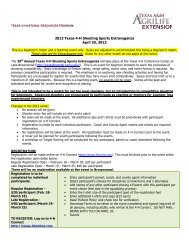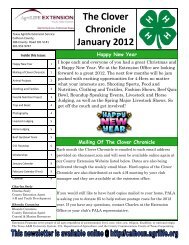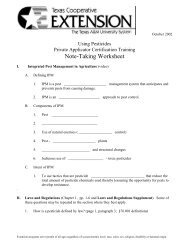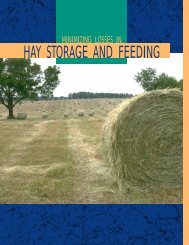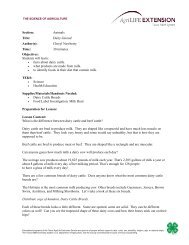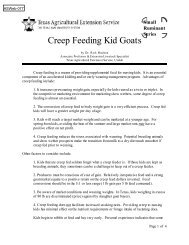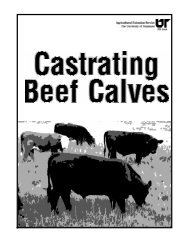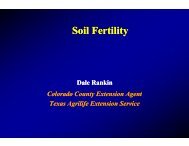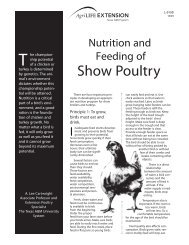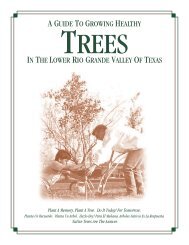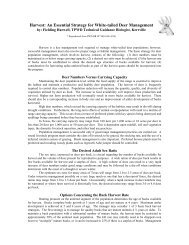Oak Leaf Roller and Springtime Defoliation of Live Oak Trees
Oak Leaf Roller and Springtime Defoliation of Live Oak Trees
Oak Leaf Roller and Springtime Defoliation of Live Oak Trees
Create successful ePaper yourself
Turn your PDF publications into a flip-book with our unique Google optimized e-Paper software.
E-206<br />
3-04<br />
<strong>Oak</strong> <strong>Leaf</strong> <strong>Roller</strong> <strong>and</strong><br />
<strong>Springtime</strong> <strong>Defoliation</strong><br />
<strong>of</strong> <strong>Live</strong> <strong>Oak</strong> <strong>Trees</strong><br />
Bastiaan “Bart” M. Drees*<br />
In early spring, many<br />
species <strong>of</strong> caterpillars can<br />
defoliate oaks <strong>and</strong> other<br />
trees. The caterpillars feed on<br />
the early spring growth <strong>and</strong><br />
occasionally will eat all <strong>of</strong> the<br />
newly emerged leaves.<br />
Two such caterpillars are<br />
the oak leaf roller, Archips<br />
Fig. 1. <strong>Oak</strong> leaf roller<br />
larva.<br />
semiferana (Walker) (Lepidoptera:<br />
Tortricidae), <strong>and</strong> an<br />
associated species, Sparganothis<br />
pettitana. These insects<br />
occur throughout Texas but<br />
are most destructive in the<br />
Hill Country <strong>and</strong> South<br />
Texas. Damaging populations<br />
have been reported in Fredericksburg,<br />
Kerrville, Boerne, New Braunfels, San<br />
Antonio, Floresville <strong>and</strong> Goliad.<br />
These species spin silken threads from which<br />
they hang when dislodged from leaves, branches<br />
or even from the trunk <strong>and</strong> nearby objects when<br />
disturbed. Other caterpillars that dangle from silk<br />
threads include the spring <strong>and</strong> fall cankerworms<br />
(<strong>of</strong>ten called "inchworms").<br />
Walking through these dangling caterpillars<br />
can be a nuisance. By mid-April this problem may<br />
be so common that many Hill Country residents<br />
completely ab<strong>and</strong>on patios <strong>and</strong> other outdoor<br />
activities because <strong>of</strong> the hundreds <strong>of</strong> dangling<br />
caterpillars.<br />
To reduce the problems caused by these caterpillars,<br />
it is helpful to know how they damage<br />
trees <strong>and</strong> to underst<strong>and</strong> their life cycle. In untreated<br />
areas, this information may not prevent<br />
encounters with dangling caterpillars. Knowing<br />
that these caterpillars are harmless to people <strong>and</strong><br />
animals <strong>and</strong> that their occurrence is seasonal may<br />
provide some comfort. Also, wearing broadrimmed<br />
hats <strong>and</strong> long-sleeved shirts while outdoors<br />
may also help prevent contact with these<br />
insects.<br />
Damage<br />
When a tree is defoliated during the growing<br />
season, it becomes stressed <strong>and</strong> occasionally serious<br />
damage can occur. Green leaves manufacture<br />
energy (sugar that is later converted into other<br />
carbohydrates) that allows the tree to grow <strong>and</strong><br />
maintain its natural vigor.<br />
Once a tree is defoliated, it essentially stops<br />
manufacturing sugar, which slows tree growth.<br />
Although deciduous trees (broad-leaved trees that<br />
generally lose their leaves each winter) can produce<br />
new leaves <strong>and</strong> stay alive for short periods,<br />
this process uses up their reserve food supply.<br />
Fig. 2. Cankerworm or inchworm.<br />
*Pr<strong>of</strong>essor <strong>and</strong> Extension Entomologist, The Texas A&M University System.
More importantly, these stressed trees are<br />
more susceptible to attack by various diseases <strong>and</strong><br />
insects. Weakened trees are extremely susceptible<br />
to wood-boring insects such as longhorn beetles,<br />
flat-headed tree borers, shot-hole borers <strong>and</strong> many<br />
clear-winged tree borers. (For more information<br />
on these insects, see the Texas Cooperative<br />
Extension publication B-5086, Wood-Boring Insects<br />
<strong>of</strong> <strong>Trees</strong> <strong>and</strong> Shrubs.)<br />
If the trees are completely defoliated year<br />
after year, especially under the drought conditions<br />
that are common across Texas, they will die.<br />
Life cycle<br />
The adult moth<br />
<strong>of</strong> the oak leaf<br />
roller, Archips semiferana,<br />
is about 1/2<br />
inch long. Its wings<br />
are mottled brown<br />
with dark brown<br />
markings. Sparganothis<br />
pettitana (no<br />
common name) has<br />
lemon yellow wings<br />
<strong>and</strong> ranges from 1/2<br />
to 3/4 inch long.<br />
Both species undergo one generation each<br />
Fig. 3. <strong>Oak</strong> leafroller moth (left) <strong>and</strong><br />
pupal skin (right).<br />
year. In May, moths <strong>of</strong> both species lay their eggs<br />
on the twig tips <strong>and</strong> leaf buds <strong>of</strong> several different<br />
tree species. The eggs remain on the buds or twigs<br />
for about 10 months <strong>and</strong> begin to hatch in mid-<br />
March.<br />
Once they hatch,<br />
the caterpillars, or larvae,<br />
feed on the tender<br />
new spring growth <strong>of</strong><br />
the trees from mid-<br />
March until late April.<br />
The larvae are creamy<br />
white to greenish <strong>and</strong><br />
have dark black or<br />
brown head capsules.<br />
They develop through<br />
several stages, or<br />
instars, as they mature<br />
to about 3/4 inch long.<br />
Fig. 4. <strong>Oak</strong> leaf roller moth<br />
larva (above) <strong>and</strong> adult (below.)<br />
<strong>Trees</strong> that are heavily infested will usually be<br />
defoliated by mid- to late April, when the fully<br />
grown caterpillars form the pupa stage on the tips<br />
<strong>of</strong> twigs, in bark crevices or on weeds <strong>and</strong> other<br />
plants growing near the infested trees.<br />
Fig. 5. <strong>Oak</strong> leaf roller, Archips semiferana (Walker) (Lepidoptera:<br />
Tortricidae) adult (left), pupal skin (center) <strong>and</strong> caterpillar<br />
(right), collected from oak trees, March 2002.<br />
At about the first <strong>of</strong> May, moths begin to<br />
emerge from the pupal stage (cocoon) <strong>and</strong> begin<br />
laying eggs on the twigs <strong>of</strong> oak, hackberry, pecan<br />
<strong>and</strong> walnut trees. These eggs will again remain<br />
dormant until the following March, thus completing<br />
the 1-year life cycle.<br />
Management<br />
For most oak trees throughout the Hill<br />
Country, it is not feasible to use insecticides to<br />
control the oak leaf roller <strong>and</strong> its related species.<br />
Often the best course <strong>of</strong> action is to simply do<br />
nothing. Post oak trees have survived in South <strong>and</strong><br />
Central Texas without human intervention<br />
through time, despite periodic pest outbreaks <strong>and</strong><br />
resulting defoliation. Caterpillar pest populations<br />
are generally cyclic, <strong>and</strong> they rarely occur year<br />
after year.<br />
The oak leaf roller does<br />
have a few natural enemies.<br />
The best natural control<br />
appears to be provided by<br />
several types <strong>of</strong> parasitic<br />
wasps that attack <strong>and</strong> kill the<br />
oak leaf rollers. However,<br />
there are seldom enough <strong>of</strong><br />
these wasps to curtail an outbreak.<br />
Certain birds, including<br />
mockingbirds, have also<br />
been observed feeding on the<br />
dangling caterpillars.<br />
Fig. 6. Close-up <strong>of</strong> oak<br />
web worm caterpillar.<br />
2
In residential situations, however, valuable<br />
l<strong>and</strong>scape or orchard trees may need to be protected<br />
from caterpillar outbreaks. Valuable l<strong>and</strong>scape<br />
trees with a history <strong>of</strong> leaf roller infestation<br />
<strong>and</strong> defoliation should be watched closely from<br />
mid- to late March. If heavy leaf-feeding damage<br />
is observed, the tree leaves can be sprayed with a<br />
registered insecticide containing either carbaryl<br />
(such as Sevin®), the insecticide that contains<br />
Bacillus thuringiensis var. kurstaki, or any <strong>of</strong> several<br />
other products labeled for control <strong>of</strong> "caterpillars"<br />
or "oakworms" on ornamental trees <strong>and</strong><br />
shrubs.<br />
To minimize stress <strong>and</strong> to restore plant vigor,<br />
oaks or other trees that have been severely defoliated<br />
in the past should be fertilized <strong>and</strong> watered<br />
regularly. Choose a balanced fertilizer (one that<br />
has equal amounts <strong>of</strong> the three major elements<br />
nitrogen, phosphorus <strong>and</strong> potassium) <strong>and</strong> apply it<br />
at the rate <strong>of</strong> 1 pound <strong>of</strong> nitrogen (N) per diameter<br />
inch <strong>of</strong> the trunk at waist height.<br />
Apply the fertilizer in a circular pattern within<br />
the tree's drip line, which is the area under<br />
a tree from the trunk to the outermost limb.<br />
For best recovery <strong>of</strong> the trees, apply ammonium<br />
sulfate (21-0-0) at the same rate 6 to 8 weeks later.<br />
Acknowledgments<br />
This fact sheet was originally developed by<br />
J. W. Stewart, Extension entomologist, <strong>and</strong> Bob<br />
Bailey, county Extension agent for Kendall<br />
County, as part <strong>of</strong> the Upper Coast series, No. 21.<br />
Their publication, <strong>Defoliation</strong> <strong>of</strong> <strong>Live</strong> <strong>Oak</strong> <strong>Trees</strong> by<br />
the <strong>Oak</strong> <strong>Leaf</strong> <strong>Roller</strong> <strong>and</strong> a Closely Related Moth, was<br />
published in April 1993.<br />
The author wishes to thank James Reinert,<br />
Roger Gold <strong>and</strong> Michael E. Merchant for review<br />
<strong>of</strong> this manuscript.<br />
Photographs <strong>and</strong> line drawings by Bastiaan<br />
"Bart" M. Drees.<br />
The information given herein is for educational purposes only. Reference to commercial<br />
products or trade names is made with the underst<strong>and</strong>ing that no discrimination is intended<br />
<strong>and</strong> no endorsement by Texas Cooperative Extension is implied.<br />
Produced by Agricultural Communications,The Texas A&M University System<br />
Extension publications can be found on the Web at: http://tcebookstore.org<br />
Visit Texas Cooperative Extension at: http://texasextension.tamu.edu<br />
Educational programs conducted by the Texas Agricultural Extension Service serve people <strong>of</strong> all ages regardless <strong>of</strong> socioeconomic level, race, color, sex, religion,<br />
h<strong>and</strong>icap or national origin.<br />
Issued in furtherance <strong>of</strong> Cooperative Extension Work in Agriculture <strong>and</strong> Home Economics,Acts <strong>of</strong> Congress <strong>of</strong> May 8, 1914, as amended, <strong>and</strong><br />
June 30, 1914, in cooperation with the United States Department <strong>of</strong> Agriculture. Chester P. Fehlis, Director, Texas Cooperative Extension,<br />
The Texas A&M University System.<br />
3



